揭示气候变化和放牧对蒙古植被的双重影响:冻土缓冲和绿化悖论
IF 5.2
1区 地球科学
Q1 ENVIRONMENTAL SCIENCES
引用次数: 0
摘要
蒙古的生态系统极易受到气候变化和过度放牧的影响,这对蒙古的生态稳定和畜牧业构成了威胁。然而,缺乏高质量的数据阻碍了对气候变率和放牧活动如何共同影响植被生长的彻底调查。本文利用长期卫星时间序列数据、现场观测数据、国家统计数据和再分析数据,研究了2000 - 2018年蒙古植被生长时空格局和驱动因素的年变化。通过归一化植被指数(NDVI),相对贡献值可以理解气候变量(降水、气温、太阳辐射和风速)和牲畜密度对植被生长的影响。结果表明:1)NDVI在生长高峰7月呈每年0.0023的显著上升趋势(p < 0.05);②控制植被生长的主导因子为降水(53.1%)、气温(33.9%)、太阳辐射(4.4%)、风速(4.6%)和牲畜密度(4.0%);Iii)考虑植被记忆效应提高了植被生长变化的解释力;(4)春季生长期开始时的降水量和气温对植被的年生长高峰起关键作用;V)多年冻土降低了植被对降水和气温变化的敏感性,从而延长了植被记忆的持续时间;NDVI绿化或表面稳定掩盖了草地的实际退化。该研究不仅加深了我们对蒙古植被变化响应环境和人为因素的认识,而且为蒙古适应性管理策略提供了科学依据。本文章由计算机程序翻译,如有差异,请以英文原文为准。
Revealing the dual impacts of climate change and grazing on vegetation in Mongolia: Permafrost buffering and the paradox of greening
Mongolia's ecosystem is highly vulnerable to both climate change and overgrazing, which threaten its ecological stability and livestock husbandry. However, the lack of high-quality data has prevented a thorough investigation into how climate variability and grazing activities jointly affect vegetation growth. Here, we applied long-term satellite time series data, in situ observations, national statistics, and reanalysis data to investigate the annual variations in the spatiotemporal patterns and drivers of vegetation growth from 2000 to 2018 in Mongolia. The relative contributions were qualified to understand how climatic variables (precipitation, air temperature, solar radiation, and wind speed) and livestock density affect vegetation growth via the normalized difference vegetation index (NDVI) as a proxy. Our findings revealed that i) the NDVI exhibited a statistically significant increasing trend of 0.0023 per year (p < 0.05) during the peak growing month of July; ii) the dominant factors controlling vegetation growth included precipitation (53.1%), air temperature (33.9%), solar radiance (4.4%), wind speed (4.6%) and livestock density (4.0%); iii) accounting for the memory effects of vegetation improved the explanatory power of vegetation growth variations; iv) precipitation and air temperature at the onset of the spring growing season were critical for the annually peak vegetation growth; v) permafrost reduced vegetation sensitivity to variations in precipitation and air temperature, thereby extending the duration of vegetation memory; and vi) NDVI greening or apparent stability masked the actual degradation of rangelands. This study not only enhances our understanding of vegetation changes in response to environmental and anthropogenic drivers but also provides a scientific basis for adaptive management strategies in Mongolia.
求助全文
通过发布文献求助,成功后即可免费获取论文全文。
去求助
来源期刊

Advances in Climate Change Research
Earth and Planetary Sciences-Atmospheric Science
CiteScore
9.80
自引率
4.10%
发文量
424
审稿时长
107 days
期刊介绍:
Advances in Climate Change Research publishes scientific research and analyses on climate change and the interactions of climate change with society. This journal encompasses basic science and economic, social, and policy research, including studies on mitigation and adaptation to climate change.
Advances in Climate Change Research attempts to promote research in climate change and provide an impetus for the application of research achievements in numerous aspects, such as socioeconomic sustainable development, responses to the adaptation and mitigation of climate change, diplomatic negotiations of climate and environment policies, and the protection and exploitation of natural resources.
 求助内容:
求助内容: 应助结果提醒方式:
应助结果提醒方式:


